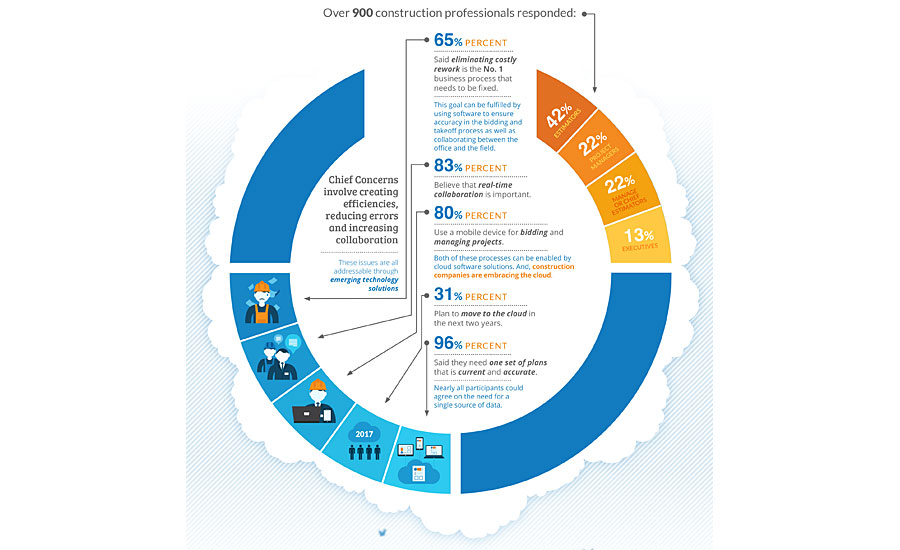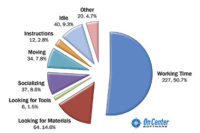Centered On Solutions
Solving Problems with Technology

2015 On Center Survey: Technology in the Construction Industry
As readers of my bylines over the years know, I have been very aware of technology changes within the construction industry. After all, it’s my business. To this point I have been a participant and an observer, helping shape these changes through the solutions marketed by On Center, then analyzing their impact on the market. Earlier this year we decided to conduct our own research. We surveyed over 900 construction professionals, comprised of 42 percent estimators, 22 percent project managers, 22 percent managers or chief estimators and 13 percent executives. Our interest was in learning what technology they are using and what their future plans looked like. What we found was an inquisitive industry, looking for answers to frustrating problems and actively moving, albeit behind other industries, to adopt technology solutions.
The On Center survey found that when asked about the importance of business processes, “minimize costly project errors and rework” was ranked as the most important by three of the four groups, totaling 65 percent of the respondents. All four groups also selected “improved communication between the field and the office” as an area of concern. We also found that all groups overwhelmingly indicated that the “ability to use a single source of data” was the most important criteria when evaluating software solution.
Collectively this data paints a picture of an industry that has been struggling with the issue of errors, based on unreliable or inadequate communication and collaboration systems between the field and the office. It pretty clear that the current system of documenting construction projects and communicating changes utilizing a variety of media and platforms is inherently flawed.
Any new solutions would, by nature, require integration with existing solutions and established best practices. More than 60 percent of the On Center respondents stated that integration was an important requirement when evaluating software providers. Additionally, estimating, takeoff and project management were the top systems identified as important to integrate.
The Cloud
These types of issues are not unique to the construction industry. Any industry that relies on input from multiple, remotely distributed assets (power and telecommunications being just two of the many), has to deal with data prone to errors and duplication. Other industries have found their answer in the adoption of cloud technologies. A recent study by IDG found that 69 percent of enterprises have either applications or infrastructure in the cloud, up from 12 percent in 2012.
To put cloud technology adoption within the construction industry into perspective, the On Center survey found that only 30 percent of respondents are currently utilizing cloud technology. Of the total 921 respondents, 31 percent indicated that they planned on moving to the cloud in 2015 or 2016. Additionally, 37 percent of executives indicated that they planned on moving to the cloud within the next one to two years and 38 percent of project managers stated the same intention. While construction lags behind the curve on adoption, we feel that if fully one third of the industry is moving to the cloud, this puts us firmly past the “early adopter” stage. It’s a trend.
Cloud Solutions
We found an interesting contradiction with the challenges expressed by companies that did not state that they were moving to the cloud. These companies cited “minimize costly project errors and rework” across the board as a chief concern. Why? Because these things cost money to remediate. Ironically, cloud solutions, which are not in their stated plans, are really the only way to eliminate these issues. Why? Because cloud solutions provide a single document for an entire company to access. Nothing else has been able to solve this problem. What our industry may be struggling with could simply come down to a matter of semantics! They’re asking for a solution that already exists, but haven’t connected the name with the technology.
Those that identified themselves as planning on moving to the cloud within the next one to two years realize why they’re doing it. They have made the rational connection, and that’s found in one of their chief motivators for making the move: the “ability to use a single source of data” was their most important criteria. Why? Because a single source of data means that there are no redundant documents that lead to—wait for it—costly field errors.
Our findings paint a clear picture of the future of technology within the construction industry. The professionals that we interacted with, and we do feel that they represent a good cross section of who we are, are seeking solutions that provide real time collaboration and will remediate errors from multiple data sources by providing a single truth for the life cycle of a construction project. The end game for this is pretty obvious, the industry can’t afford to lose revenues based on errors and reworks. And why should it? The tools for change exist and we’re moving towards taking advantage of them. If there’s one thing that the survey indicated, it’s this: we seem to know that the answer to our problem exists and we’re slowly connecting to dots to find it.
Looking for a reprint of this article?
From high-res PDFs to custom plaques, order your copy today!





